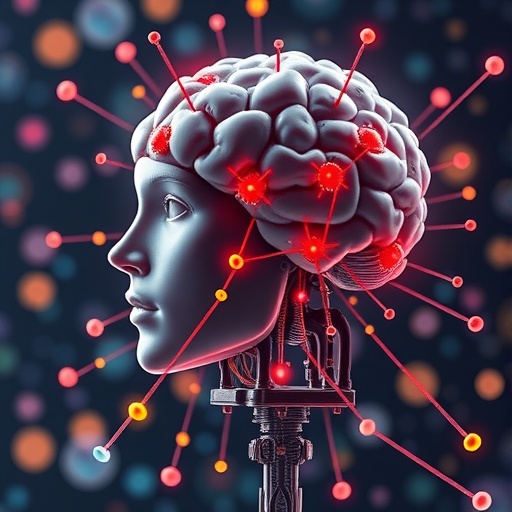A Groundbreaking Leap in Understanding Human Decision-Making Through Model-Guided Scientific Discovery
In recent advances at the intersection of artificial intelligence and cognitive science, researchers have unveiled a transformative approach to decode the intricacies of human decision-making. By integrating cutting-edge foundation models with classical cognitive theories, this novel framework offers unparalleled insights into how people process choices involving multiple attributes. The synergy between language-based reasoning models and state-of-the-art predictive engines has opened a new frontier, bridging natural human behavior and formal computational representations.
Central to this breakthrough are two complementary tools: Psych-101, a repository of human behavioral data encoded in natural language, and Centaur, a pioneering black-box predictive model. Psych-101’s human-readable data format enables seamless interaction with language models such as DeepSeek-R1, which was harnessed to generate verbal hypotheses explaining participants’ choices in complex decision scenarios. This innovative marriage of cognitive data and language processing marked the first step in unraveling an adaptive decision-making strategy that had eluded classical analysis.
.adsslot_PtHqONamye{width:728px !important;height:90px !important;}
@media(max-width:1199px){ .adsslot_PtHqONamye{width:468px !important;height:60px !important;}
}
@media(max-width:767px){ .adsslot_PtHqONamye{width:320px !important;height:50px !important;}
}
ADVERTISEMENT
The multi-attribute decision-making task employed in the study provided participants with pairs of products, each rated on four expert criteria. The challenge for individuals was to select the preferred product. DeepSeek-R1 synthesized participant behavior into a compelling verbal strategy, describing a two-step heuristic approach: initially tallying which product accrued the majority of positive expert ratings, and, in case of ties, deferring to the judgment of the most credible expert. This nuanced combination of established heuristics—majority rule and expert prioritization—appeared novel within the scientific discourse.
Converting this verbal hypothesis into a formal computational model yielded promising results. The newly implemented strategy surpassed traditional models evaluated previously, such as weighted-additive schema, equal weighting, and take-the-best heuristics. The performance gains underscored the power of integrating language-based hypotheses with quantitative modeling, creating a feedback loop where cognitive insights guide model refinement.
Despite this advancement, the DeepSeek-R1-derived model’s fit to empirical data, as quantified by the Akaike information criterion (AIC), revealed scope for improvement. Specifically, an AIC score of 181.7 was favorable but significantly inferior to Centaur’s remarkable 72.5, suggesting that Centaur captures subtleties of human decision patterns that still elude simpler heuristic models. This discrepancy triggered the adoption of scientific regret minimization, a novel strategy leveraging a reference model to detect where a candidate cognitive model fails despite available predictive information.
Analysis under scientific regret minimization spotlighted specific decision instances where the DeepSeek-R1 model faltered but Centaur succeeded. Intriguingly, these cases involved choices contrary to majority positive ratings but favored by an expert with higher validity. Such decisions reveal a more fluid interplay between heuristics than a strict priority hierarchy. This insight prompted researchers to relax the binary rule-switching mechanism by replacing it with a weighted average blending the two heuristics, capturing subtler cognitive processes.
The refined model attained near parity with Centaur’s predictive performance, reflected in an improved AIC of 71.7. Crucially, it retained interpretability—a prized feature facilitating understanding and communication of underlying cognitive strategies—while embracing a richer representation of decision-making complexity. This balance addresses a perennial tension in cognitive modeling between transparency and accuracy.
To rigorously compare all candidate models, investigators performed group-level model selection, estimating the protected exceedance probability—a metric denoting the probability that a model is more frequently employed within a population than its competitors. The model emerging from scientific regret minimization dominated with a probability of 0.83, a stark contrast to results obtained from the original model suite. This significant shift not only vindicates the iterative refinement process but also provides robust evidence that human decision-making involves an integrated heuristic combination rather than a monolithic weighted-additive approach.
The implications for psychology and artificial intelligence are profound. By harnessing foundation models capable of black-box predictions alongside interpretable cognitive constructs, researchers have charted a path toward richer, more nuanced characterizations of the human mind. This hybrid methodology enables exploratory hypothesis generation and rigorous model testing without prohibitive data demands, democratizing scientific discovery in cognitive psychology.
Beyond methodological innovation, these findings illuminate fundamental aspects of human cognition, particularly how individuals navigate complex choices by leveraging a flexible, context-sensitive blend of heuristics. Such adaptive strategies may confer evolutionary advantages, allowing rapid, yet sophisticated decision-making in environments characterized by uncertainty and competing cues.
Moreover, this research exemplifies a new paradigm where natural language understanding systems and advanced predictive models collaborate symbiotically. Language models translate raw behavioral data into verbal theories, which then inform computational formalizations refined against predictive benchmarks. This cyclical process fosters a dynamic, iterative scientific method amplified by artificial intelligence.
Looking ahead, the convergence of foundation models with cognitive science invites exciting possibilities. Expanding these techniques to diverse decision contexts, social cognition, and even clinical assessments could revolutionize fields ranging from economics to mental health. As AI tools continue to evolve, their capacity to unravel the complex tapestry of human thought promises to unlock mysteries once thought intractable.
In sum, the integration of Psych-101, DeepSeek-R1, and Centaur embodies a landmark in scientific modeling, revealing human decision strategies as an elegant entwining of heuristics modulated by context and expert influence. This work not only advances theoretical understanding but also showcases an innovative blueprint for future research at the nexus of psychology and artificial intelligence—a partnership poised to shape the science of cognition in the years to come.
Subject of Research: Human decision-making and cognitive model development through AI-guided scientific discovery
Article Title: A foundation model to predict and capture human cognition
Article References:
Binz, M., Akata, E., Bethge, M. et al. A foundation model to predict and capture human cognition. Nature (2025). https://doi.org/10.1038/s41586-025-09215-4
Image Credits: AI Generated
Tags: adaptive decision-making strategiesAI and human cognitionCentaur predictive model in AIcomputational representations of human behaviordecision-making processes in AIfoundation models in cognitive scienceintegration of cognitive theories and AIlanguage-based reasoning in AImulti-attribute decision-making strategiespredictive modeling in decision-makingPsych-101 behavioral data repositoryverbal hypotheses in decision-making





